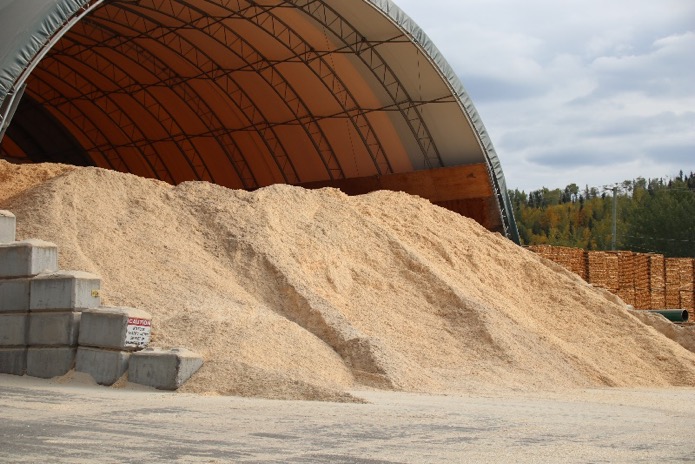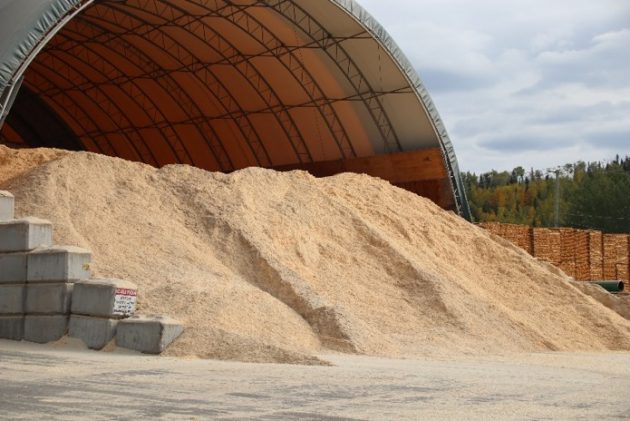
Features
Health and Safety
Sawmilling
Best practices for managing wood fibre storage and combustible dust
June 23, 2020 By Fahimeh Yazdan Panah
 Raw material storage at wood pellet plant. Photo courtesy WPAC.
Raw material storage at wood pellet plant. Photo courtesy WPAC. Combustible wood dust in confined storage could present a risk of fire and explosion if it’s not managed effectively. The Wood Pellet Association of Canada (WPAC) has developed tools to improve safety and lower the risk when working around wood fibre storage.
In 2017, the Wood Pellet Association of Canada (WPAC)’s Safety Committee, in collaboration with the BC Forest Safety Council (BCFSC), the Manufacturing Advisory Group and WorkSafeBC, established a Working Group to lead the process on developing best practices for combustible dust management in wood fibre storage. This collaboration resulted in the formation of the Wood Fibre Storage Working Group (WFSWG), with the overall objective of improving safety within the wood manufacturing sector by eliminating injuries and fatalities
The objectives were to:
- Assist employers in understanding and assessing the hazards of storing and handling wood fibre in areas intended for storage and infeed processes.
- Provide guidance on developing and implementing risk mitigation strategies and preferred operating practices, including training of workers and supervisors.
- Provide direction on potential audit elements or standards for fibre storage to be incorporated into the WPAC/BCFSC Combustible Dust Audit; and
- Consult with WorkSafeBC on inspection and compliance requirements related to the storage of wood fibre in buildings and structures intended for that purpose.
After consulting with WorkSafeBC and following their recommendations for industry programs on combustible wood dust inspection and management, the working group developed guidelines for the management of both wood fibre storage and combustible dust, which includes documents on risks and mitigation and gap analysis, as well as a safety bulletin.
The risk and mitigation document lists the potential ignition sources and highlights leading/best mitigation options when working in and around wood fibre, with a focus on storage buildings/structures, mobile equipment, luminaries, electrical distribution equipment, conveyors, and bins.

Raw material storage at wood pellet plant. Photo courtesy WPAC.
The gap analysis tool was developed to help employers assess the potential hazards, identify gaps in their safety management system and implement control measures to mitigate risk. It includes a list of 12 components for safety management system requirements for storage infrastructure, storage building luminaries, electrical distribution equipment, infeed process, fibre delivery/acquisition, mobile equipment and inspections, cleaning and maintenance. It also provides such requirements for safety management: roles and responsibilities, documentation – identification and maintenance of applicable regulations, training, awareness and competence, emergency preparedness and response, performance measurement, management review, and communications.
Finally, the safety bulletin covers the main considerations in fire prevention and best practices when managing wood fibre with mobile equipment to ensure the risk of fire or deflagration is effectively addressed:
- It is critical to ensure properly trained personnel operate mobile equipment.
- All mobile equipment should be inspected and cleaned
- Ensure automatic extinguishing systems are installed on engine and hydraulic components. It is recommended to inspect the general condition of the extinguishing system at least weekly; inspect the dry chemical for free flow capability at least monthly; and establish a quarterly maintenance program that includes checking for free movement of the actuator mechanism.
- To reduce the risk of sparks and fire, protected wiring, air operated starting and enclosed batteries are highly recommended.
- Water cooled manifold and muffler are strongly recommended to bring down the surface temperature and thus reduce fire risk.
- Mobile equipment should never be left unattended or parked in storage areas.
- Reversing engine fan can help minimizing wood dust/fibre accumulation within the engine compartment.
- It is recommended to have additional extinguishers available on the mobile equipment and within the storage area.
- Coating or insulation on turbos are recommended to reduce surface temperatures and thus the risk of fire.
- Interlocks on hydraulic systems are recommended as they allow the flow of hydraulic fluid to be stopped effectively in the event of a leak and thus reduce the risk of fire.
For more information, contact:
Fahimeh Yazdan Panah
Email: fahimeh@pellet.org
Tel: (778) 990 -2656
Or visit www.bcforestsafe.org/node/2730.
[This article is part of our 2020 Dust Safety Week coverage. Find more articles here.]
Print this page